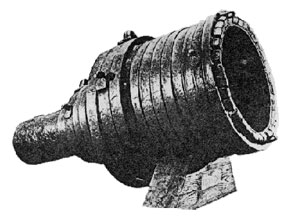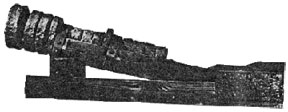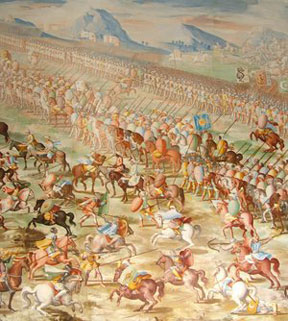| Cannon of Granada
By Mike Bennighof, Ph.D.
October 2023

They thought that the
thunder and the lightning had come down
from the skies;
whereas the thunder and lightning are all
around them being created by man.
These are things of wondrous shapes,
sent high by Hermes and engineered to demolish
mountains when they hit.
Yes, it is this world that always shows
you miracles,
since nature’s innate powers are destined
to appear
Abu Zakariyya Yahya
ibn Hudhayl
poem to celebrate the fall of Huescar, 1324
 Historians dispute exactly when European
armies first deployed gunpowder weapons, dating
them to the late 14th century. The French
appear to have been the first to make use
of cannon, against the English at Perigord
in 1339. Gunpowder weapons first had a major
impact during the wars of Jan Hus in Bohemia
between 1419 and 1434, and in some of the
later battles of the Hundred Years’
War particularly at Formigny in 1450. Historians dispute exactly when European
armies first deployed gunpowder weapons, dating
them to the late 14th century. The French
appear to have been the first to make use
of cannon, against the English at Perigord
in 1339. Gunpowder weapons first had a major
impact during the wars of Jan Hus in Bohemia
between 1419 and 1434, and in some of the
later battles of the Hundred Years’
War particularly at Formigny in 1450.
Ferdinand of Aragon brought along a large
siege train of modern artillery for the Spanish
invasion of Granada in 1481. These were bombards,
big heavy pieces designed to smash city walls
and other fortifications by heaving large
stone balls at them. Most of the gunners appear
to have been European mercenaries, lured by
high pay, religious conviction or some combination
of the two.
Slow and Unsteady

A heavy wrought-iron bombard of the
early 1400s, a type that would later
be classed as a siege mortar.
|
A typical bombard was a two-piece iron tube
mounted on a heavy wooden frame. Wheeled carriages
for artillery appeared only in the late 1490s,
after the end of Granada’s last war. The
larger section, known as the barrel, was loaded
from the muzzle end with the heavy ball. The
second, smaller section, known as the powder
chamber, went behind it and contained of course
the gunpowder charge. Bombards were constructed
in this manner to allow a narrow powder chamber,
thus concentrating the force of the explosion,
and a large-diameter barrel to allow use of
large projectiles.
Although the two pieces were assembled into
one during manufacture, the era’s technology
would not allow a perfect seal between them,
and gas leakage was a serious problem.
Bombards were made of hammer-forged wrought
iron, usually “banded” for greater
strength. Because of the forging method, the
barrels could not be made of uniform thickness
and weak spots were common. If the explosive
force broke through one of these spots, the
entire gun could explode with devastating
effects on the crew (and also on the army’s
morale). Barrel explosions were common, and
gunners received such high pay because of
the danger involved.
By the late 1400s, manufacturers had begun
to turn out cast-bronze bombards, which featured
much more consistency and thus were less prone
to explode. All of the cannon deployed in
Granada appear to have been of wrought iron,
however.
A bombard required a crew of between 10 and
20, only a few of whom needed to be highly
paid specialists — most were laborers
needed to shift the heavy gun. They fired
projectiles of about 200 pounds, to a range
of about 200 meters. Rate of fire was very
low; even a skilled crew needed about 30 minutes
to prepare and fire the gun. In the Castillian
forces assembled by Ferdinand and Isabella
the gunners were civilian contractors, not
subject to military discipline.
Islamic Artillery

An Austrian bombard of about 1450; very
similar to those used by Ferdinand of
Aragon.
|
In siege warfare, a bombard could do terrific
damage to the stone battlements of European
fortresses, which had not been designed to
resist projectiles. In field battle they were
less useful but still could be important for
a defending army, as their flash and noise
frightened both horses and inexperienced soldiers.
The Egyptian Mamelukes deployed artillery
very effectively to this purpose in 1260 at
the Battle of Ayn Jalut, stampeding the horses
of the Mongols and inflicting the first defeat
suffered by the horde.
During the early Renaissance period, the
Islamic world retained a significant technological
edge over the European Christians. The Muslim
Kingdom of Granada used gunpowder weapons
well before its Christian adversaries. During
King Ferdinand III’s 17-month siege
of Seville in 1248 and 1249 the Muslim defenders
deployed both cannon and rockets against the
Christians but ultimately could not keep the
great city from falling. Many Spanish historians
do not accept this early event and instead
point to the siege of Niebla in 1262, when
the defenders deployed “engines that
projected stones and fire accompanied by thundering
noises.”
The dispute here is not whether gunpowder
was used, but whether or not it provided the
propellant force for the weapon. The chronicles
are unclear but hint that the Granadans may
have been flinging pots of gunpowder with
standard catapults and similar devices. In
later centuries, European and especially Spanish
historians scoffed at the notion that Muslim
armies might have been more technologically
advanced than their Christian enemies. But
even the children of Granada deployed gunpowder
fireworks to celebrate holidays by the late
13th century.
By 1324, King Abu al-Walid Ismail ibn Nasr
of Granada was definitely deploying cannon
in the siege of Huescar. “He headed
towards the enemy territory and challenged
the fort of Huescar that stands as a bone
in the throat of Baza, which he besieged and
attacked,” one of his young pages, Lisan
al-Din ibn al-Khatib, wrote later. “He
struck the arch of the invincible tower with
a red-hot iron ball bombarded by the great
engine that operates by gunpowder.”
His successor, Muhammed IV, used cannon in
his own siege of Alicante in 1331, and the
defenders of Al-Jazira (Algeciras) deployed
both cannon and hand-operated guns during
the 20-month siege of 1341 and 42. Spanish
kings began to hire Moorish mercenaries from
Granada to introduce cannon to their own arsenals.
Guns at Granada

Granada’s elite Jewish light cavalry
skirmishes at the Battle of Higueruela,
1431.
|
During the 1481 to 1492 war, Granada did not
deploy cannon on nearly the same scale as did
the Spanish invaders, but the weapons were well
known in the kingdom and available for use.
In our Granada game, the Moorish player does not have siege
guns in his arsenal, though the Spaniard has
three of them (and they are vital if the Spanish
player hopes to win the game).
As a game variant, add two siege guns to
the Moorish player’s order of battle.
They are available only as reinforcements,
one of them appearing at Granada on a reinforcement
die roll result of 8 or better. You can download
the new Moorish artillery pieces here.
You can get some advice on how to make playing pieces right here.
You can download Granada right here.
It’s $29.99, but if you’re a Gold Club member, it’s free to you as part of the Golden Library (there’s no Gold Club discount or freeness through Wargame Vault).
Click here to join the Gold Club
See your Gold Club Insider newsletter for ordering information.
Golden Chipboard
 Ten (10) chipboard sheets, slightly thicker than the ones we use for game pieces, for use in pasting up your own counters from our downloadable games and expansions. Ten (10) chipboard sheets, slightly thicker than the ones we use for game pieces, for use in pasting up your own counters from our downloadable games and expansions.
You can order Golden Chipboard right here.
You can order sticky label paper here.
Sign up for our newsletter right here. Your info will never be sold or transferred; we'll just use it to update you on new games and new offers.
Mike Bennighof is president of Avalanche Press and holds a doctorate in history from Emory University. A Fulbright Scholar and NASA Journalist in Space finalist, he has published a great many books, games and articles on historical subjects; people are saying that some of them are actually good.
He lives in Birmingham, Alabama with his wife, three children, and his new puppy. He misses his Iron Dog, Leopold.
Want to keep Daily Content free of third-party ads? You can send us some love (and cash) through this link right here.
|
